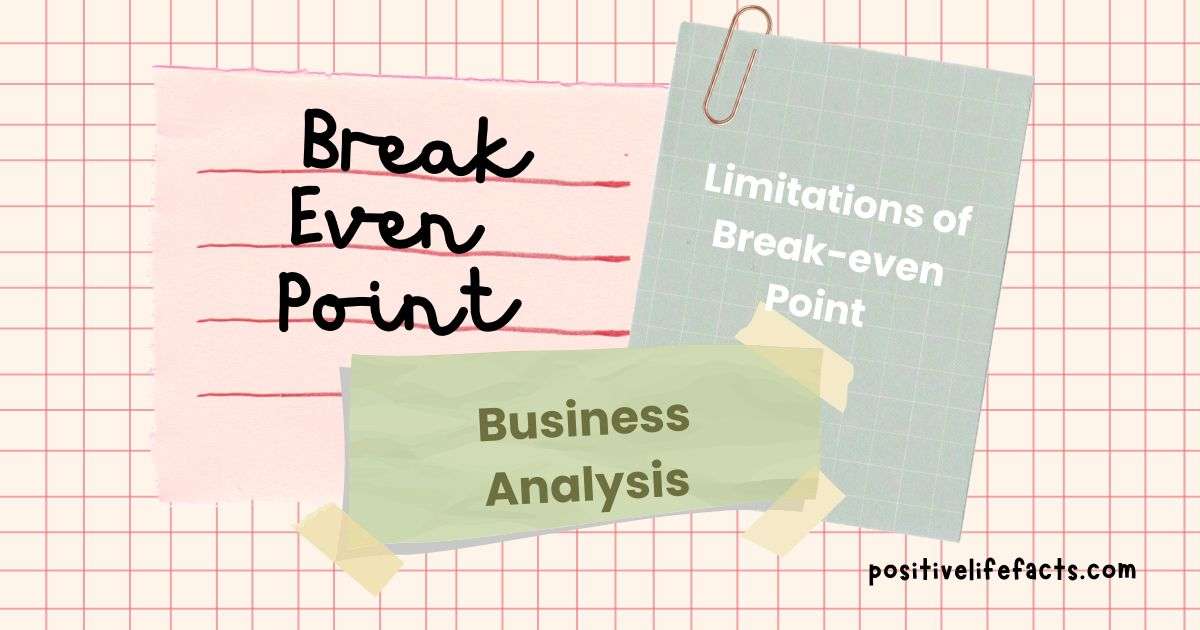Introduction to Break-even Point
The break-even point (BEP) is a critical financial metric used by businesses to determine when they will start making a profit. In simple terms, it’s the point where total revenues equal total costs. Break-even analysis helps businesses figure out how many units they need to sell to cover their costs.
But, while the break-even point seems like a straightforward tool, it has its limitations. And for a business to fully rely on it can sometimes be misleading. Let’s explore these limitations and how they can impact decision-making in the real world.
“Some of the links in this post are affiliate links. ‘As an Amazon Associate I earn from qualifying purchase.’ This means if you click on the link and purchased the item. I will receive an affiliate commission at no extra cost to you. All opinions remain my own.”
How Break-even Point is Calculated
The formula to calculate the break-even point is:
Break Even Point (in Units) = Fixed Cost ⁄ (Sales price per unit – Variable cost per unit)
This formula separates costs into two main categories: fixed
costs (costs that don’t change with production levels, such as rent) and variable
costs (costs that change depending on production, like raw materials). The
break-even analysis assumes that these costs are linear, which brings us to its
first limitation.
Significance of Break-even Analysis
Understanding your break-even point helps with basic business planning, especially when you’re setting sales targets or pricing strategies. However, while it’s good at offering quick insight into whether you’re covering costs, there are many underlying complexities that it overlooks.
Limitations of Break-even Point
1. Over-Simplification of Costs
One of the biggest weaknesses of break-even analysis is that it assumes a linear relationship between costs and revenues. In reality, costs and revenues don’t always behave predictably. For example:
- Assumes Linear Relationship Between Costs and Revenues: While the formula assumes that variable costs per unit remain constant, in practice, they can fluctuate. Suppliers might offer bulk discounts, or costs might rise due to shortages.
2. Ignores Market Conditions
Break-even analysis doesn’t take into account external factors like market demand, competition, and pricing strategies. It assumes that you’ll be able to sell a certain number of units at a fixed price, but markets are rarely so predictable.
- Pricing Strategy Changes: Competitors might lower their prices, forcing you to lower yours, which will affect the break-even point.
- Competitor Actions: If a competitor launches a new product, demand for your product could decrease, making it harder to hit your break-even point.
3. Limited Focus on Short-term
Break-even analysis mainly focuses on the short-term. It doesn’t consider long-term variables such as changing customer preferences, technological advancements, or future expansions.
- Fails to Consider Long-term Factors: It’s a snapshot that doesn’t reflect the evolving dynamics of the market or business.
4. Assumes Constant Sales Price
In the real world, prices fluctuate due to promotions, discounts, or inflation. Break-even analysis assumes that you will sell all your products at the same price, which is rarely the case.
- Price Fluctuations and Their Impact: Temporary price drops, seasonal sales, or special offers can greatly affect your break-even point. If you’re offering a discount, you’ll need to sell more to break even.
5. Neglects Capacity and Production Constraints
Another limitation is that break-even analysis doesn’t factor in your business’s production capacity. It assumes you can produce and sell an unlimited number of units, but real-world production is limited by resources, workforce, and time.
- Operating Below or Above Capacity: Producing below capacity increases fixed costs per unit, while operating above capacity could increase variable costs, both of which affect the break-even point.
6. Doesn’t Account for Mixed Product Lines
If your business sells more than one product, break-even analysis becomes complicated. The formula is designed for a single product or service. But in reality, most businesses have a range of products with different prices and costs.
- Complexities of Multi-product Businesses: Different products will have different margins, making it challenging to calculate a single break-even point for the entire business.
Break-even Point and Risk Assessment
The break-even point is limited in its ability to assess risk. While it shows when you’ll start covering costs, it doesn’t give a complete picture of business risk. For example, it doesn’t tell you about the likelihood of actually selling the number of units needed to break even.
- Real-life Business Complexities: A real-world business environment involves fluctuating demand, changing market conditions, and operational risks that break-even analysis doesn’t capture.
Impact of Economic Factors on Break-even Point
Economic variables such as inflation, currency exchange rates, and taxes can drastically change both fixed and variable costs, affecting the break-even point. For example:
- Inflation and Cost Variations: As inflation rises, both variable and fixed costs can increase, leading to a higher break-even point.
- Exchange Rates and Global Operations: For businesses that deal with international markets, changes in exchange rates can have a significant impact on the break-even point, as material costs might fluctuate.
Case Study: Break-even Point in Small Businesses
Many small businesses overestimate the usefulness of break-even analysis. They assume that once they reach the break-even point, they’ll instantly start making profits. However, small businesses often face hidden costs, underestimation of expenses, and fluctuating sales, all of which make the theoretical break-even point difficult to achieve in practice.
- The Reality vs. Theoretical Model: In real life, the model can look very different. Businesses often encounter unexpected expenses, and revenue may not be as consistent as forecasted.
Technological Advancements and Break-even Analysis
With advances in technology, businesses now have tools that make it easier to perform more accurate break-even analyses. Tools that incorporate real-time data and predictive analytics can provide a more dynamic and realistic assessment of costs and revenues.
- Real-time Data and Predictive Analytics: These tools help businesses adjust their pricing, costs, and sales targets on the fly, offering a more flexible and accurate analysis compared to the static nature of traditional break-even analysis.
Alternative Approaches to Break-even Analysis
Given the limitations of the break-even point, businesses often supplement it with other financial tools to get a fuller picture of profitability:
- Contribution Margin Analysis: Focuses on the profitability of individual products.
- Profitability Index: Measures the profitability of different investment projects.
- Sensitivity Analysis: Assesses how different variables impact profitability, providing a more nuanced understanding of risks.
The Future of Break-even Analysis
With the rise of artificial intelligence and machine learning, break-even analysis could become more sophisticated. AI tools can integrate more variables into the calculation, such as market trends, competitor behavior, and real-time cost fluctuations, making the analysis far more accurate and useful for businesses.
Conclusion
While break-even analysis remains a valuable tool, it’s clear that its limitations must be understood to avoid faulty decision-making. It’s best used alongside other analytical tools to provide a more comprehensive view of business performance. For businesses to thrive, especially in dynamic markets, they need to go beyond just knowing their break-even point and factor in the real-world complexities.
[WPSM_AC id=2228]

